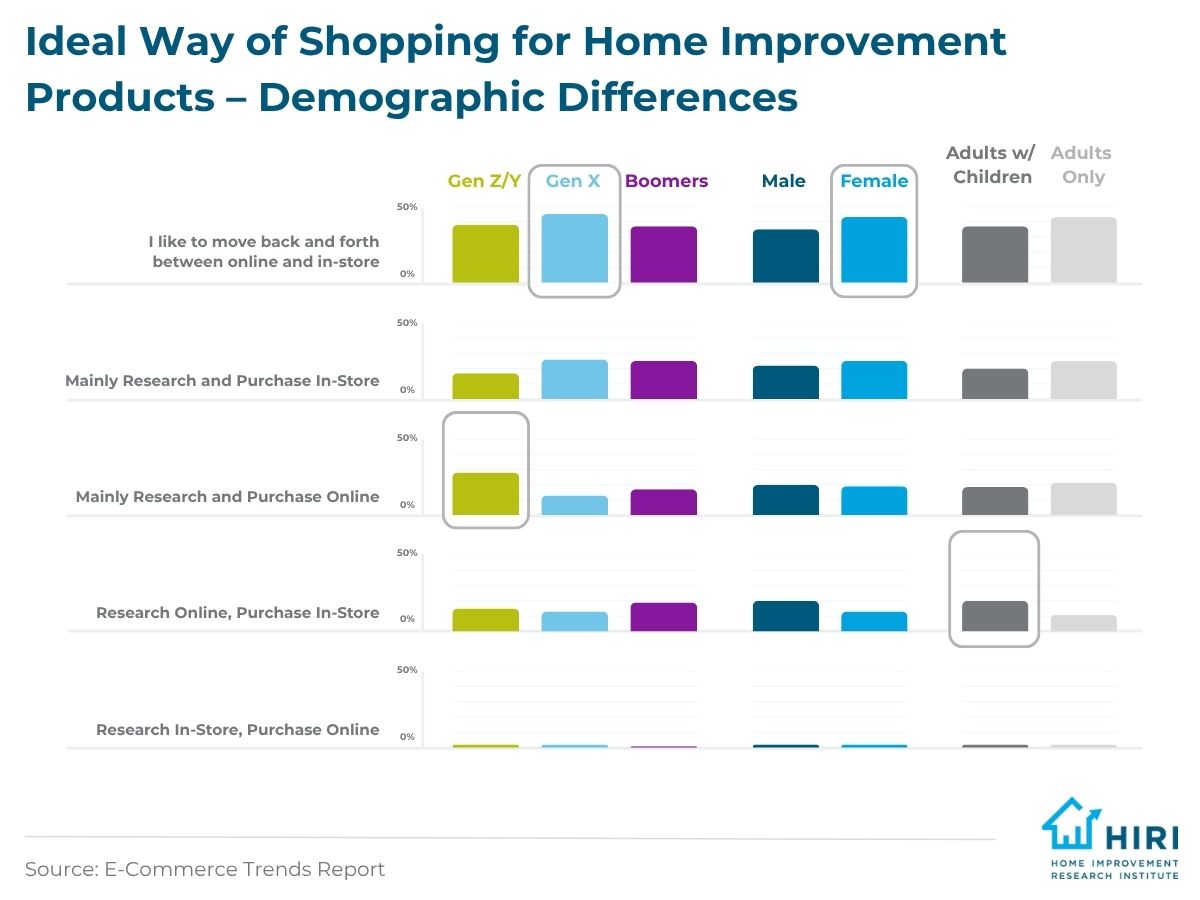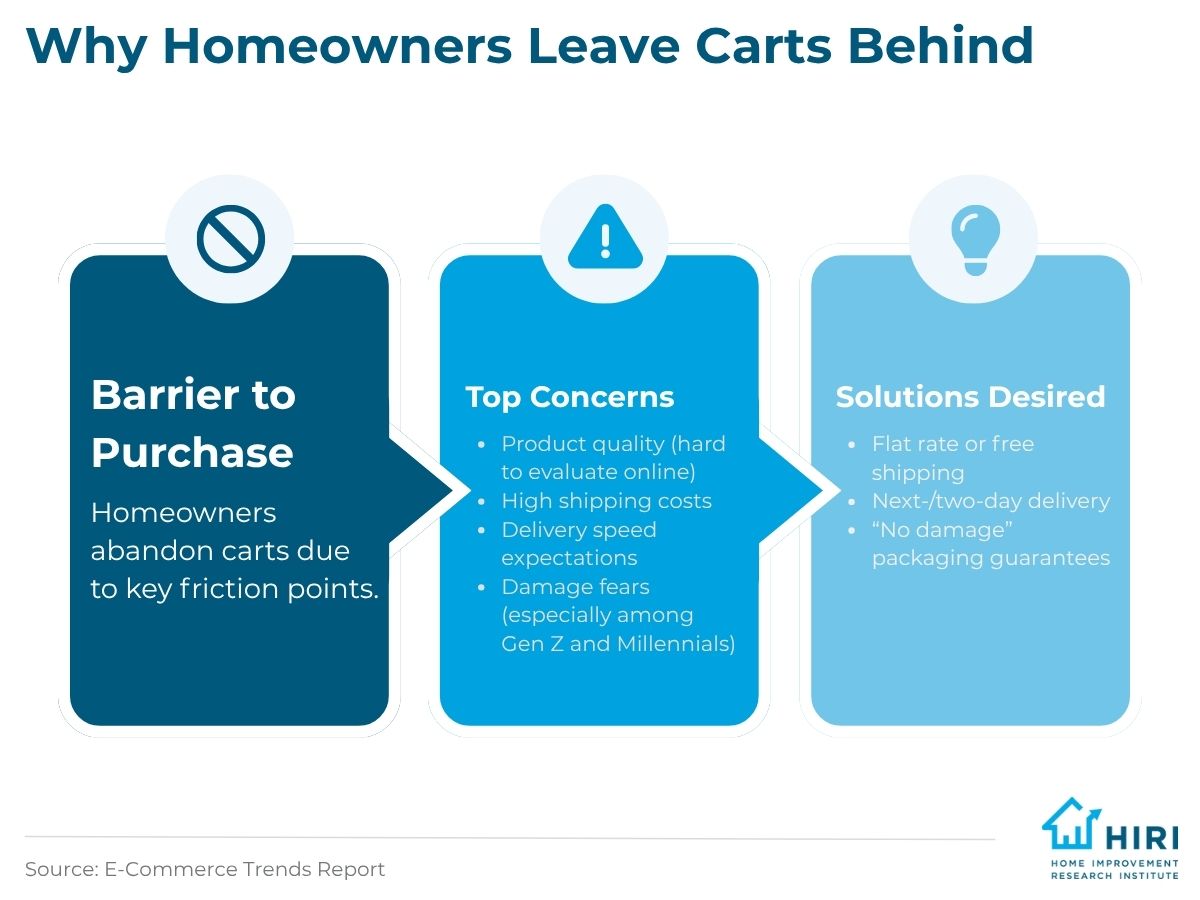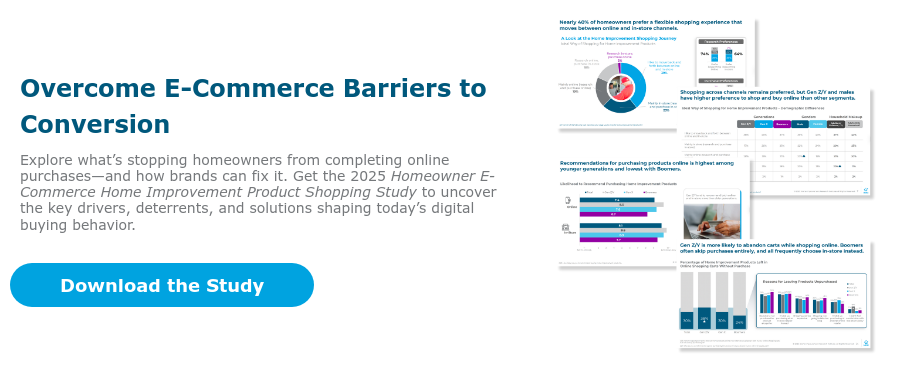
Home Improvement E-Commerce Trends Among Homeowners in 2025
Jul 18, 2025
E‑commerce is a prevalent part of the shopping experience in this day and age. Individuals needing products for their home improvement projects utilize digital sources at nearly every step of the shopper journey, from exploring brands and researching product details to making actual purchases.There are several nuances, though, when it comes to the attitudes and behaviors that influence shopping for home improvement products and materials. Baby Boomers much prefer the experience of brick-and-mortar establishments. Gen Z and Millennial shoppers are more likely to abandon carts when shopping online. Awareness and use of emerging e‑commerce technologies are growing, but not everyone sees technology as the solution to their struggles with online shopping.The Home Improvement Research Institute’s recently published Homeowner E‑Commerce Study offers a closer look at these trends, along with data about these three distinct segments and the differences in their attitudes around online shopping. Armed with the full insights, you and your team can improve strategies so that your home improvement brand can better engage each one.
What Factors and Trends Influence the Home Improvement Shopping Journey?
The omni-channel home improvement shopping journey is complex. For marketing managers and team members involved in promoting products and converting customers, it’s important to identify demographic variations, address barriers to online purchasing, and understand the impact of emerging e‑commerce technologies on the homeowner shopping experience.Here is a look at some of the insights from our Homeowner E‑Commerce Study and how it applies to your manufacturing brand in 2025:
1. Online Channels are Used for More than Purchasing
Online channels are critical at all stages of the shopper journey, regardless of where the final purchase takes place. For example, according to our research, more than half of in-store purchases involve prior online research. About 40% of homeowners also prefer a flexible shopping experience and being able to move seamlessly between online and in-store channels. For marketing managers, it’s important to ensure accuracy and consistency across channels, especially when it comes to pricing, promotions, inventory, and product data. Your team also should prioritize seamless transitions and integrating user-friendly digital touchpoints.
2. Variances Exist Among Different Demographics
It probably comes as no surprise that younger generations, such as Millennials and Gen Z, lead in online behaviors, while older generations maintain the desire for shopping in stores. However, our study uncovers other nuances among the different demographics and their preferred way of shopping for home improvement products. For instance, adults with children are twice as likely as adults-only households to prefer researching products online and then purchasing them in store. Household makeup, gender, and generation affiliation are all factors that can influence preferences and behaviors.

HIRI members have access to the full report which dives into greater detail.
3. Artificial Intelligence (AI) and Social Media Appeal to Younger Generations
Both online sources and in-store visits are heavily used as the “first stop” when shopping for home improvement products. When it comes to AI solutions — such as Gemini and ChatGPT — and social media platforms, there is an obvious difference between folks from the older generations, including Boomers and Gen X, and Millennials and Gen Z. They are more likely to use these resources when they start their shopping journey, with nearly one in 10 utilizing social media platforms. Additionally, about a third of Gen Z and Millennial shoppers say they check social media for product recommendations about 50% to 74% of the time before making a purchase. This presents an opportunity for home improvement brands to capture the attention of younger shoppers through strategic advertising and promotions on these channels. It’s also important to offer a seamless transition from social media links and posts to specific landing pages on your website.
4. Homeowners Prefer to See Costly or Complex Products in Person
Homeowners vary on how they approach certain product categories. While more affordable or basic items rarely require in-person viewing, there are certain products that they prioritize seeing for themselves before making a purchase. Our research delves into how homeowners feel about different product categories and the level of importance they place on seeing a product in-person before making a purchase. The categories with the highest level of importance to see produce in person before making a purchase include cabinets, flooring, exterior doors, and countertops, while homeowners don’t feel it’s as important to preview more basic products, including fasteners (nails, screws, and bolts), insulation and weatherization products, and adhesives, caulks, sealants, and tapes.
5. Urgency Prompts an Influx of In-Store Purchases
In general, most homeowners buy in-store and take the items directly with them. When purchasing online, the preference is home delivery, with Millennials and Gen Z shoppers more likely than others to choose store pickup. But different home improvement situations can influence different shopping behaviors. Our research shows that when it comes to urgent needs and emergency repairs, nearly three-fourths of purchases take place in the store. For planned projects — particularly minor projects with fewer products — behaviors shift, with 30% of shoppers preferring to make purchases mostly online.
6. Product Quality and Shipping Costs Pose Barriers to E‑Commerce Conversions
For marketing managers, one challenge can be to increase actual online conversions. Certainly, homeowners may be willing to look around e‑commerce sites and even add items to their cart, but something stops them before they complete the purchase. Our research shows that some of the main barriers that undermine conversion include difficulty evaluating product quality, high shipping costs, and the need for same-day delivery or pickup. More than a third of homeowners abandon their online shopping carts because of these issues. Additionally, Gen Z and Millennials show a higher concern about their products arriving damaged. The study digs into some desired solutions, or improvements that might encourage more online purchases, such as guaranteed next-day or two-day delivery, flat rate or free shipping, and certified “no damage” packaging guarantees.

7. Trust Issues Persist Among Online Shoppers
New technology can be exciting, and online features — from digital wallets and augmented reality (AR) to chatbot advice for home improvement project planning — are gaining traction. In particular, personalized artificial intelligence (AI) product recommendations are the most tried and used solution, with more than half of shoppers having experimented with this technology. Digital wallets, such as Apple Pay, are the most-used type of digital-purchasing method for home improvement products. But there is still a significant level of distrust, particularly among older generations, and many shoppers don’t see 3D and AR tools as a way to mitigate their struggle with judging product quality online. Meanwhile, a significant percentage of Gen Z and Millennial shoppers don’t feel that AI-powered recommendations are personalized enough. To address these concerns, your team can work to maintain a high level of transparency and integrate digital tools that are privacy conscious, trustworthy and intuitive.
8. Shoppers Still Appreciate a Human Touch and They’re Selective About Technological Solutions
It’s also important for home improvement brands to understand their demographics’ opinions about technologies and digital tools. What are they actually hoping to get out of emerging e‑commerce technologies? Integrating a technology just for the sake of doing so isn’t going to improve brand loyalty or boost online conversions. But there are a few areas where homeowners look toward new technology to improve their shopping journey, such as product visualization and accurate tracking/shipping details. Along the same lines, it’s important to not abandon all human touchpoints or try to replace them with digital tools, especially within the home improvement industry. Based on our research, shoppers, particularly from older generations, still prefer interacting with humans on support chats or through live consultations.
Gaining Access to Deeper Insights to Improve the Omnichannel Shopping Journey
As digital shopping continues to evolve, homeowners are increasingly blending online and in-store experiences when shopping for home improvement products. While physical stores remain the primary purchase point, online research and e‑commerce are playing a critical role in shaping buying decisions. Become a HIRI member to gain full access to our Homeowner E‑Commerce Study and other important research about the behaviors, barriers, and innovations shaping the home improvement market.
HIRI members have exclusive access to ~$1M of annual research, which covers Channel, Product, Project, and Market Size activity for both Homeowners/DIYers and Contractors. HIRI is the best source of secondary home improvement information. To leverage HIRI data ensures your organization has a strong, foundational comprehension of the industry and dynamics impacting it.

